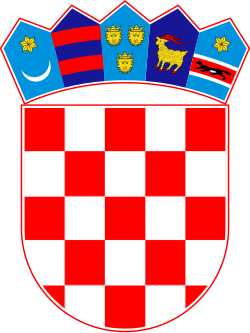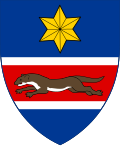Meaning
Since the 19th century national revival in Croatia, the oldest Croatian coat of arms with three leopard/lion heads was appropriated by the Italian-Dalmatianist irredentist Autonomist Party, [4] making the checkerboard coat of arms the preferred Croatian national symbol. [4] As such, it sparked the need to find and prove its old age, and consequently fabrications of an early medieval origin. One tradition states it to be the arms of Stephen Držislav in the 10th century. [7] A Split stone baptistry from the time of Peter Krešimir IV (r. 1058–1074/5) has engraved falcons that carry something that resembles a checkerboard on their wings, and the bell tower of the medieval Church of St. Lucy, Jurandvor has a checkerboard pattern carved onto it. [8] It was traditionally conjectured that the colors originally represented Red Croatia and White Croatia, but there is no historical evidence to support this as well.
Recently modern scholars are arguing that the Croatian checkerboard coat of arms (CoA) was probably created under the influence of the Habsburg dynasty, replacing the first CoA with leopard/lion heads (becoming attributed to the Dalmatia, meanwhile in Venetian Dalmatia was replaced by the Lion of Saint Mark [4] ), which checkerboard with red-white fields stylistically to the trend of the time denotes the walls and forts as Antemurale Christianitatis . [9] [2]
Use
The checkerboard coat of arms (šahovnica) is first attested as a decorative symbol of the Kingdom of Croatia on an Innsbruck tower depicting the emblem of Maximilian I, Archduke of Austria in 1495, [10] [11] [12] and Chiesa dei Domenicani in Bolzano, Italy also from the late 15th century. [9] There's possible analogies dating to 1426 of Swedish nobleman Heindrik Kristiernsson who served Ivan VI Frankopan, and 1491 of Senj nobleman Ludovik Perović at the Co-Cathedral of the Assumption of Mary, Senj. [13] [14] It officially appeared on a seal from the Cetingrad Charter that confirmed the 1527 election of Ferdinand I, Archduke of Austria as new king of Croatia. [11] [15] [16]
Towards the Late Middle Ages the distinction for the three crown lands (Croatia proper, Dalmatia, Slavonia) was made. The šahovnica was used as the coat of arms of Croatia proper & together with the shields of Slavonia and Dalmatia was often used to represent the whole of Croatia in Austria-Hungary. It was used as an unofficial coat of arms of the Kingdom of Croatia adopted in 1848 and as an official coat of arms of the post-1868 Kingdom of Croatia-Slavonia (both unofficially known as the Triune Kingdom). The two are the same except for the position of the šahovnica and Dalmatian coat of arms which are switched around & with different crowns used above the shield – the later employing St Stephen's crown (associated with Hungarian kings).
By late 19th century šahovnica had come to be considered a generally recognized symbol for Croats and Croatia and in 1919, it was included in the coat of arms of the Kingdom of Serbs, Croats and Slovenes (later the Kingdom of Yugoslavia) to represent Croats. When the Banovina of Croatia was formed, the šahovnica (checkerboard gules and argent) was retained as the official symbol.
The Ustaše regime which had ruled Croatia during the World War II superimposed their ideological symbol, the letter "U" above or around the šahovnica (upper left square white) as the official national symbol during their rule.
After the Second World War, the new Socialist Republic of Croatia became a part of the federal Second Yugoslavia. The šahovnica was included in the new socialist coat of arms. [17] It was designed in the socialist tradition, including symbols like wheat for peasants and an anvil for workers, as well as a rising sun to symbolize a new morning and a red star for communism.
During the change to multiparty elections in Croatia (as part of the collapse of Communist rule in Eastern Europe from the late 1980s), and prior to the establishment of the current design, the šahovnica, shedding the communist symbols that were the hallmark of Croatia in the second Yugoslavia, reappeared as a stand-alone symbol as both the 'upper left square red' and 'upper left square white' variants. The choice of 'upper left square red' or 'upper left square white' was often dictated by heraldic laws and aesthetic requirements.
The first-field-white variant was adopted by the Republic of Croatia and used briefly in 1990. [18] According to constitutional changes which came into effect on 26 June 1990 the red star in the flag of SR Croatia was to be replaced by the "historical Croatian coat of arms with 25 red and white fields", without specifying order of fields. [19] The first-field-white variant was used at the official flag hoisting ceremony on 25 July and was later occasionally used on par with the first-field-red variant until 21 December 1990 when the current coat of arms was officially adopted. [19] [20]
































